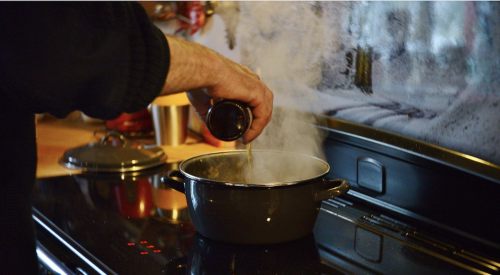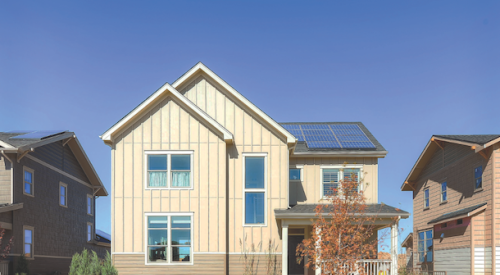| Artistic Homes uses blown insulation because it provides full coverage and helps tighten a home. Use of 2x6, 24-inch on-center advanced framing with single top plates reduces framing members in exterior walls by one-third, allowing for more blown insulation. |
Artistic Homes was already the largest builder in New Mexico when, 18 months ago, it re-engineered its building system from top to bottom. Combining that makeover with a major buyer education program substantially increased sales for the Albuquerque-based company.
In 2000, Artistic sold 689 homes, priced from $80,000 to $115,000, to first-time buyers. Last year, after it changed building practices, Artistic closed 852 units, despite national-level market uncertainties and slightly higher prices. This year the company is on pace to break 900. “We’re selling them as fast as we can build them,” says Max Wade, part of the father-and-sons team that owns and operates Artistic.
A recent groundbreaking partnership with the Energy & Environmental Building Association and the New Mexico branch of the American Lung Association should push sales even faster. But building the foundation for that partnership wasn’t easy.
Starting Over
After a long search for a production builder program that would help it offer more value to buyers, Artistic signed on in 2000 with Building America, a program funded by the U.S. Department of Energy. One of the DOE’s five consultants, Building Science Corp. (Westford, Mass.), provided detailed guidance and on-site training.
| The supply plenum and short supply runs (right boot) are in a pre-drywalled dropped soffit in the central hallway. Return air is drawn back through the soffit/drywall “plenum,” entering through transfer air grilles (left boot). This redesigned ductwork is a key to Artistic’s “Comfort Guarantee.” |
Building America provides “a systems approach to designing and building healthy, comfortable, durable, energy-efficient and environmentally responsible homes.” While following Building America guidelines typically costs more, there are ways to achieve dollar savings that trim net costs (e.g., more money on windows and less on air-conditioning equipment). The goal, when utility bills are factored in, is that buyers shouldn’t pay more to own these homes.
“The Building America standard is the biggest change in the construction industry since I started building in 1965,” says Jerry Wade, Max’s dad and Artistic’s founder. “This isn’t easy. In fact, it’s a total pain, and there is a big learning curve. It’s been tough on our subs, retraining the framers, plumbers, HVAC contractors, electricians, everyone. All along the way there is resistance to these changes because we’re creatures of habit. Nobody wants to say, ‘We’ve been doing it wrong all these years,’ and yet we have. We have succeeded in building houses that are unhealthy.”
Systematic Changes
The “systems approach” requires that a builder go beyond good workmanship and good materials. Today’s homes perform differently than those in the past. For example, atmospherically vented water heaters have a reasonable safety record, but in a tighter house a larger exhaust fan can easily back-draft exhaust gases down water heater flues. So builders must focus on the interactive impacts that new products and practices have on home performance.
“It’s been our goal to make an improvement every year, and this is our biggest improvement ever,” Jerry Wade says. “It starts with drawing. We’ve had to do some redesign on every one of our 16 sets of plans. And from this we’ve learned that there aren’t too many who really know how to draw a correct set of plans.”
|
The list of Artistic’s new features is lengthy. It starts with advanced framing: 2x6s at 24-inch centers, with cavities blown full of fiberglass insulation. Spectrally selective low-E vinyl windows cut down heating and cooling loads. Every home is tested and energy-rated to make sure all the tightness details are properly installed. To prevent intrusion of rainwater, flashings around all windows and doors are carefully integrated with a drainage plane covering exterior walls.
Space heating is provided by combo water heaters. Ductwork that used to drape through attics is placed in a special dropped ceiling running down hallways. Carefully sealed and tested for tightness, the ductwork then is hooked up to an air handler that does triple duty: It circulates fresh outdoor air, heated air and cooled air. For combustion safety, all combustion appliances must be direct-vented, power-vented or sealed combustion. No atmospherically vented appliances are allowed.
At first, the new package and performance testing bumped Artistic’s costs up $2,500 to $3,000 per house. The need to build a dropped, drywalled cavity to carry hallway ductwork increased the construction cycle from 41 to 45 days. Switching from swamp coolers to refrigerated air was the largest cost hit. With experience, the initial net cost increase has narrowed to about $1,500.
HVAC and Guarantees
|
|
|
|
|
|
|
|
|
|
|
|
|
|
Complete redesign of its HVAC systems created the biggest hurdle because Artistic’s longtime HVAC contractor didn’t believe that the new system and seriously downsized equipment could heat and cool effectively. So Max Wade took him to out-of-state Building America projects to show how they performed. Still skeptical, the contractor agreed to install a few of the new systems to prove they would not work. Now Max says the contractor is the system’s strongest supporter.
Artistic liked the results from its test homes. “The first homes were super-comfortable and energy-efficient,” Jerry Wade says. “So we made the commitment to build all our houses to the new standard. Now it’s helping us capture more of the market because there is nothing better being built out there.”
Artistic is one of a small but growing group of production builders that guarantee comfort and utility bills. Comfort can be subjective, so Artistic spells it out for buyers: no more than a 3-degree difference in room-to-room temperatures. In the first 100 homes, a couple of homeowners complained about comfort. Faulty equipment caused the problem in one case, and in the other simple temperature measurements documented for the sensitive homeowner that the home met the performance spec.
The ALA Link
Artistic’s systems approach to health and safety allowed it to kick off in June a first-ever Partnership for Healthy Indoor Air Quality with EEBA and the ALA of New Mexico.
To display the ALA logo, homes must meet rigorous indoor air-quality standards. They include continuous controlled ventilation when the building is occupied; additional spot ventilation in kitchens and baths; elimination of atmospherically vented combustion appliances; ducts sealed with mastic, located within the conditioned space and tested for tightness; maximums for measured pressure differentials from room to room; and use of low-VOC paints.
“Now I’m building the best house I know how to build,” Jerry Wade says. “We’ve gotten great support. Our buyers move into $80,000 houses that are more comfortable and have cleaner air than the $400,000 home I live in today. This is benefiting consumers.”
Steve Andrews is a Denver-based energy consultant and freelance writer.










